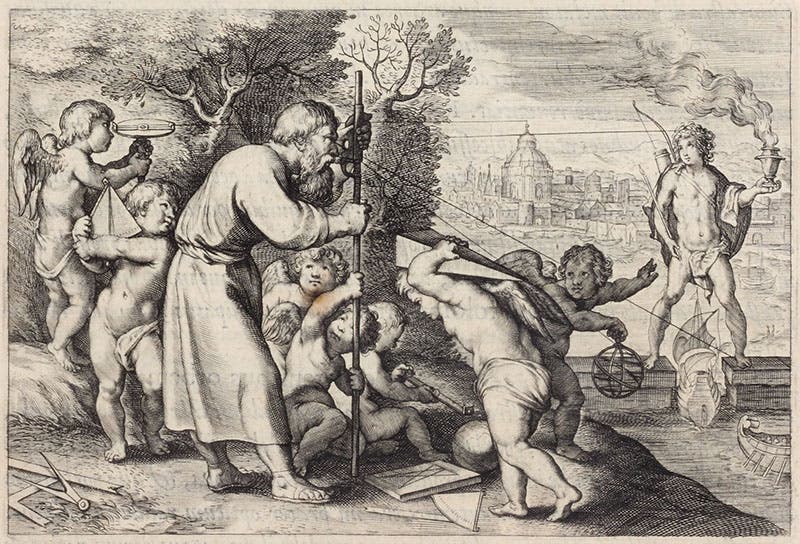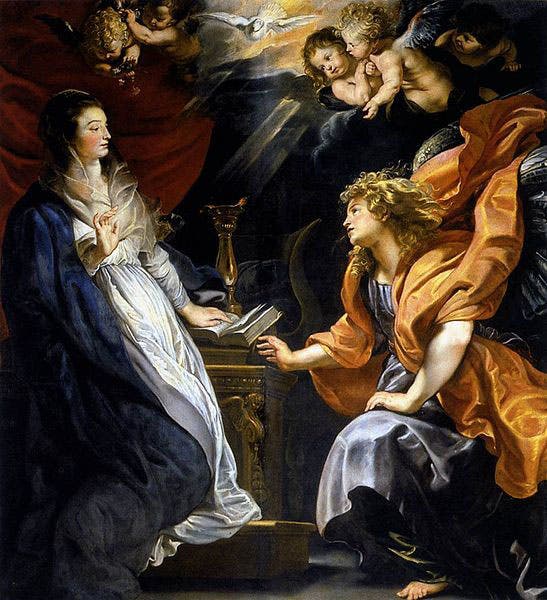Scientist of the Day - François d’Aguilon
François d'Aguilon, a Flemish Jesuit geometer, was born Jan. 4, 1567. In 1613, Aguilon published the book for which he is best known, Opticorum libri sex (Six Books on Optics). Unfortunately for Aguilon, the book is best known for the engraved title page and six large engraved headpieces, which were designed, not by Aguilon, but by Peter Paul Rubens. The title engraving (second image) is rather ordinary - one wonders if Rubens assigned it to an assistant - but the engraved vignettes are inspired. Each of Aguilon's six books addressed a different subject - the physiology of the eye, vision with two eyes, optical projections - and each of the vignettes portrays some object or event relevant to that chapter, usually involving an aged natural philosopher and three or more helpful putti.
The headpiece for Book One, for example (third image), shows three putti dissecting an eyeball, under the watchful eye of the philosopher, while two others point to the empty eye-socket of the head of a cyclops, who apparently contributed the subject matter of the dissection.
Another (fourth image) shows the philosopher measuring the height of the Colossus of Rhodes while his assistants putter about. The most acclaimed vignette, because of its graceful design, opens Book 6, showing the philosopher, Atlas-like, holding an armillary sphere on his shoulder, while the putti assist in making a stereographic projection of the sphere on the flat ground (first image).
But this is Aguilon's birthday, not Rubens, so we hasten to point out that in addition to providing a forum for Rubens' artwork, the Opticorum libri sex also made a significant contribution to color theory. There had been little advance in color theory since Aristotle, until Aguilon suggested that, in addition to white (albus) and black (niger), the most important elements of Aristotle's color theory, there are three other primary colors: yellow (flavus), red (rubeus) and blue (caeruleus). Aguilon provides a graphical diagram in Book 1 of the Opticorum (fifth image).
By combining two of the primary colors, one can fashion three secondary colors: orange (aureus) from yellow and red, purple (purpureus) from red and blue, and green (viridis) from yellow and blue. Aguilon then tells the reader how to put this theory to good use in the practice of mixing pigments, suggesting that perhaps Rubens had a little input here as well. Indeed, several art historians have pointed out that several of Rubens’ paintings of this period seem almost intended to demonstrate Aguilon's color mixing.
Rubens' Annunciation in Vienna, for example (sixth image), painted around 1609/10, uses the primary colors for Mary, while the archangel Gabriel wears garments of orange, purple, and green, the three secondary colors. It is too bad that printing techniques of the day did not allow the reproduction of this painting as the frontispiece to Aguilon’s book. That would have been a knockout!
Dr. William B. Ashworth, Jr., Consultant for the History of Science, Linda Hall Library and Associate Professor, Department of History, University of Missouri-Kansas City. Comments or corrections are welcome; please direct to ashworthw@umkc.edu.










